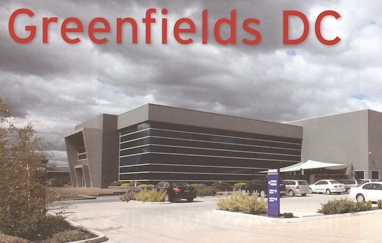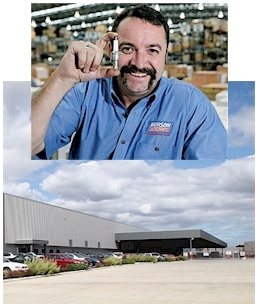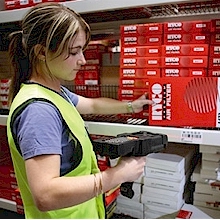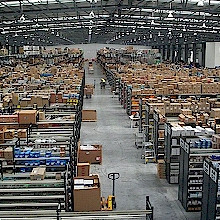
Burson Automotive showcases it's new Greenfield DC
 |
When leading Australian auto parts distributor Burson Automotive moved to a new greenfields distribution centre in the Melbourne suburb of Preston, the principal motivation was the need to cater for significant business growth.
That said, Burson elected to use this relocation as an opportunity to totally rethink and streamline its total logistics operations. Thus discussions were begun with suppliers to ensure all inbound stock was properly identified and barcoded. A comprehensive new warehouse design and layout was proposed, based on a full analysis of the organisation’s business flows. Receiving, put-away, picking, replenishment, and despatch processes were substantially re-engineered. And finally, the decision was taken to implement an advanced warehouse management system.
Now, nearly two years later, Burson reports the successful completion of this major logistics project. The final step completed last year was the picking of more than 1,200 daily ‘vehicle off road’ or emergency orders now being routinely handled by only four staff using the Pulse warehouse management system (WMS).
Established in 1971 by managing director Garry Johnson, the genesis of the Burson business was the distribution of a range of automotive chemical products that were sold to workshops and service stations from a single ‘cash van’. Today the company employs over 700 team members in 66 auto parts stores located throughout Victoria, Tasmania, New South Wales, and Queensland. With a major focus on serving the auto trade for all of their aptly named ‘aftermarket’ requirements, the new 12,000 square metre Burson DC typically ships 15,000 line items per day, and receives a comparable number of new stock receipts.
Prior to relocating to the new DC at Preston, Burson was based in the Melbourne suburb of Heidelberg. Continuing business expansion forced the company to add to its then single warehouse, by acquiring a similarly-sized warehouse on an adjacent site. This scenario presented an inherent range of efficiency challenges. Of principal concern, however, was that this second warehouse had also quickly reached its capacity. And hence the decision was taken, in 2004, to move to a brand new purpose-designed and substantially larger facility. As an indication of Burson’s growth, the company had 17 stores when it moved into the first warehouse at Heidelberg, and had 58 stores when the decision to relocate to Preston was taken.
As Garry Johnson notes: “We started with an empty block of land and a blank sheet of paper. Our aim was to create the most efficient distribution centre possible. And so as well as taking a huge amount of care with the new building’s design, we also elected to put each and every aspect of our logistics operations under the microscope. Our view was quite simply that if we could do something better, we would.
“When we began our logistics review we felt we were not getting the job done as well as we could. Some of our systems and procedures had simply evolved over time. And so our ambition was to do things a little bit smarter”, Garry Johnson said.
Looking back on that review process, distribution centre manager Andrew Crockett explains: “One of our first tasks was to identify the type of storage we would need for each SKU and each product range. Our aim here was to match the product ranges and parts to the ideal storage options available such as binning, shelving, mixed pallet, and full pallet.
“The importance of this was paramount, given that we have some 35,000 active SKUs, and a total number of 320,000 SKUs. These, in turn, range from small washers, light globes, spark plugs, fan belts and rubber hoses to engine blocks, tool boxes and oil drums. In addition, small items may have a high turnover and big items may have a small turnover. All of these combinations needed to be taken into account in determining an optimum match of SKUs to the various different storage options.
“As part and parcel of this, we also looked at each of our warehouse operations to identify which processes were the most intensive and demanding. Our conclusion here was that receiving and put-away carried one of the biggest workloads. For example, with the Narva range of items, spanning such things as lights, globes, and fuses, one delivery from the supplier can be as many as 40 pages with each page containing 30 separate items. As such, put-away became one of the top three drivers of how the new Preston distribution centre would be set up.
“So putting storage considerations and DC workflow analysis together, our logic was that we had to break away from traditional logistics thinking and processes that essentially do not suit the auto parts business. Such conventional logic would typically say ‘put big items somewhere and small items somewhere else’. In contrast, our thinking was to group together like products irrespective of size.
“Our concept for the new DC, therefore, was all about creating product ‘zones’, with like products, such as electrical, being grouped together. It was then at the zone level that big parts and small parts are separated in storage types. So overall the plan saw our SKUs being slotted first by storage type and then by putaway and replenishment type.
“In doing this we subsequently took into account a number of major picking considerations. We knew, for example, that some parts would need a dedicated pallet picking location. And so these were appropriately allocated but again under the zone-by-zone thinking we had already proposed.
“In fitting out the DC, we chose a mixture of four, six, eight and ten-shelf bays to optimally meet our requirements. The type of product was logically matched to the type of shelving chosen. Items were then slotted based on transaction volumes. And here, at least, we were able to work with traditional logistics thinking by having the fastest moving items close to receipt and despatch and also placed so they did not operationally impact on each other,” Andrew Crockett explained. “With this all locked away, our next question was how to most effectively and efficiently get products that had been picked to despatch, with this step previously having been a largely manual process. Our decision in this regard was to place despatch in the middle of the building, with shelving to one side and bulk storage to the other. To bring everything together, we then specified a conveyor sortation system that would work in conjunction with the Pulse WMS. With the conveyor, individual totes and cartons are automatically taken to the correct despatch grid where they are consolidated with bulk picks prior to despatch. “At the same time we also had to streamline procedures to cater for the varying product handling requirements of different SKUs. So, for instance, a drum of oil obviously needs to be handled totally differently to a light globe. Here we again split operations, this time into those managing small and fragile items and those responsible for large and heavy items. | Burson’s new 12,000 square metre DC and Burson Automotive distribution centre manager Andrew Crockett |
The logic here is that we take a pallet to a location to collect the large heavy items, such as engines or oil drums, with this then being moved to the despatch grid. In the meantime, small parts for the same order are being picked into totes, which are then taken to despatch by the sortation system, where they are simply loaded on top of the awaiting pallet.
“Next on the review agenda was a comprehensive examination of picking. To achieve maximum efficiency, we took the warehouse layout blueprint already agreed and fine-tuned it to streamline order processing. So for our small parts, we elected to set up 24 aisles which were then, in turn, divided into our concept of zones and then picking areas. Picking teams were also allocated on a zone-by-zone basis, and to further streamline their
work we designed purpose-built trolleys to enable four orders to be picked on each picking assignment.
“In practical terms, this means that a single order can be split and can be picked concurrently in several zones, including the bulk storage zone. And to drive our new way of picking and to accurately consolidate orders and make the whole process work effectively, an advanced WMS was absolutely mandatory.
“During this review and planning process, we also made a point of working with our key suppliers. The success of a project like this demands working closely with all key stakeholders. So with all of our major suppliers, we spent time with their people and asked questions such as ‘how do you manage your operations’ and ‘how might you work with us to help us make our operations more efficient’. This was not only about trying
to get them to change their processes, but also to see where there were very real opportunities to get a better result for ourselves”, Andrew Crockett noted.
Burson Automotive utilise the latest in RF technlogy to improve accuracy | With such extensive planning in place, Burson then produced a detailed specification for its WMS. A number of options were considered, with the final decision being to install the Pulse WMS, based on, as Andrew Crockett notes, “a set of criteria including system capabilities, automotive industry specific features, flexibility, experience, and service. “From a capabilities viewpoint, for example, one of the most important requirements was to identify a WMS that was able to manage the diabolically complex part numbering that exists in the automotive industry. A single SKU, for example, may be sourced from several different suppliers, with each supplier using their own product numbers. And of course the supplier product numbers may not be unique. Therefore we need to be able to handle duplicate product numbers. Further compounding the problem, the barcode on the product may contain a totally different number than the supplier product number. And indeed the duplicate part numbers are for totally different parts. Pulse was certainly |
“Also key was the ability of the Pulse WMS to help drive the DC’s inventory accuracy. We do hold a significant range of items at the store level, particularly for common items that have a high demand. However, for a lot of products, stock is only held at the distribution centre. This may be because of the size of the items, or because demand is low, or because we may only ever have a very small quantity in stock overall.
“In the later instances, a store must have absolute confidence that if the system says an item is in stock, it must be in stock. The store must be able to say to a customer ‘yes we have this part in stock and we can deliver it to you this afternoon’.
“Equally vital for our stores is picking accuracy. If they have a customer waiting on an urgent delivery, there is an obvious problem if the wrong items are shipped. Here again there can be a great similarity in many part numbers and so we saw barcode scanning as an absolute imperative. In implementing this we also spoke to all of our suppliers to ensure all products we receive from them are properly barcoded.
In considering the contribution now being made by the system, Garry Johnson notes that all objectives to date have been met. Including the requirement that introducing the system had to be achieved without stopping the business even momentarily.
“With Pulse giving us total inventory accuracy, it means our stores no longer need to check their deliveries from the DC and we can purchase far better. Remember that we work in a market that is continually changing. New vehicles are constantly being introduced and so new parts are needed. At the same time demand for old parts continually declines. Multiply that conundrum across our extensive product range and the scope of the challenge can be readily seen. Success here involves a range of things, but if you don’t have complete stock accuracy as a foundation, then you are starting off behind the eight ball.
“There are, nonetheless, still a few important WMS facilities we have not yet fully implemented, although there are plans to do so as soon as we feel it is appropriate. We are starting a continuous cycle counting program this year, for example, with the aim here being to totally count the inventory twice per annum. By starting this in 2007, we have built up accurate SKU stock history and that will permit us to identify which areas, if any, are giving us problems. With that history we will also be able to do far more in terms of analysis and that will really help us reach our full potential in terms of WMS usage and operational efficiency.”
Published in  |
Why PULSE.WMS?
Ask yourself why are so many growing organisations implementing WMS alongside their existing or new business systems such as ERP and MRP? – As organisations struggle with diminishing product margins and less room for price negotiation they are turning attention to often out of control and increasing Supply Chain costs.
Following meticulous reviews of their existing and new business system requirements, savvy companies have identified that the ERP warehousing modules on offer just don’t have deep enough functionality to strip costs out of their supply chain, and cannot match their competitors who are operating with an advanced WMS.
For more information click here to contact us.






